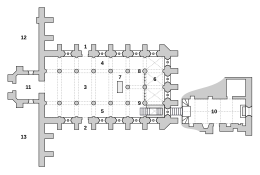| Rosslyn Chapel | |
|---|---|
 Rosslyn Chapel, August 2014 | |
| 55°51′19″N 3°09′37″W / 55.85528°N 3.16028°W | |
| OS grid reference | NT275630 |
| Location | Roslin, Midlothian |
| Country | Scotland |
| Denomination | Scottish Episcopal Church |
| Previous denomination | Catholic Church |
| Website | www |
| History | |
| Status | Chapel |
| Dedication | Saint Matthew |
| Architecture | |
| Functional status | Active |
| Heritage designation | Category A |
| Groundbreaking | 20 September 1456 |
| Administration | |
| Diocese | Edinburgh |
| Clergy | |
| Priest in charge | The Revd Gill Hitchen |
Listed Building – Category A | |
| Official name | Rosslyn Chapel (Episcopal), formerly Collegiate Church of St Matthew, including vaults, burial ground and boundary hills |
| Designated | 22 January 1971 |
| Reference no. | 13028[1] |
Rosslyn Chapel, also known as the Collegiate Chapel of Saint Matthew, is a 15th-century Episcopal chapel located in the village of Roslin in Midlothian, Scotland. The chapel was founded by William Sinclair, 1st Earl of Caithness with a ground-breaking ceremony in 1456. After the Scottish Reformation in 1560, it was largely abandoned but, following a visit by Queen Victoria, it was rededicated in 1862. It was the target of a bombing in 1914 during the suffragette bombing and arson campaign. The interior contains some fine carvings which many historians have sought to interpret.
Since the late 1980s, the chapel has been the subject of speculative theories concerning a connection with the Knights Templar and the Holy Grail, and Freemasonry. It was prominently featured in this role in Dan Brown's bestselling novel The Da Vinci Code (2003) and its 2006 film adaptation. Medieval historians say these accounts have no basis in fact. Rosslyn Chapel remains privately owned.

- North entrance
- South entrance
- Choir
- North aisle
- South aisle
- Lady chapel
- Altar
- Master pillar
- Apprentice pillar
- Sacristy
- Baptistery
- North transept
- South transept
- ^ Historic Environment Scotland. "Rosslyn Chapel (LB13028)". Retrieved 30 November 2016.
